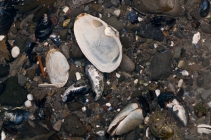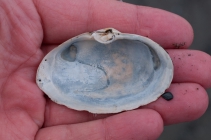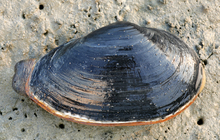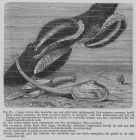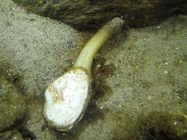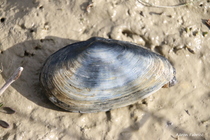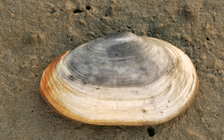
| Intro | | Search taxa | | Browse taxa | | Distributions | | Terminology | | References | | Statistics | | Online sources | | Tutorial | | Log in |
WoRMS taxon detailsMya arenaria Linnaeus, 1758
140430 (urn:lsid:marinespecies.org:taxname:140430)
accepted
Species
Arenomya arenaria (Linnaeus, 1758) · unaccepted
Mya (Arenomya) arenaria Linnaeus, 1758 · unaccepted
Mya (Arenomya) arenaria oonogai Makiyama, 1935 · unaccepted
Mya acuta Say, 1822 · unaccepted
Mya acuta mercenaria Say, 1822 · unaccepted
Mya alba Agassiz, 1839 · unaccepted
Mya arenaria var. corbuloides Comfort, 1938 · unaccepted
Mya arenaria var. ovata A. S. Jensen, 1900 · unaccepted (synonym)
Mya communis Megerle von Mühlfeld, 1811 · unaccepted
Mya corpulenta Conrad, 1845 † · unaccepted > junior subjective synonym
Mya declivis Pennant, 1777 · unaccepted
Mya elongata Locard, 1886 · unaccepted
Mya hemphilli Newcomb, 1874 · unaccepted
Mya lata J. Sowerby, 1815 † · unaccepted
Mya mercenaria Say, 1822 · unaccepted
Mya oonogai Makiyama, 1935 · unaccepted
Mya subovata S. Woodward, 1833 · unaccepted
Mya subtruncata S. Woodward, 1833 · unaccepted
Sphenia ovoidea P. P. Carpenter, 1865 · unaccepted > junior subjective synonym
marine,
recent + fossil
Linnaeus, C. (1758). Systema Naturae per regna tria naturae, secundum classes, ordines, genera, species, cum characteribus, differentiis, synonymis, locis. [The system of nature through the three kingdoms of nature, according to classes, orders, genera, species, with characters, differences, synonyms, places.]. <em>Impensis Direct. Laurentii Salvii. Holmiae [Stockholm].</em> 1(10) [iii], 824 p., available online at https://biodiversitylibrary.org/page/726886
page(s): 670 [details] Available for editors
Distribution Labrador to off Georgia; Western Europe
Distribution Labrador to off Georgia; Western Europe [details] Distribution Circumboreal, not reaching the Mediterranean
Distribution Circumboreal, not reaching the Mediterranean [details]
MolluscaBase eds. (2025). MolluscaBase. Mya arenaria Linnaeus, 1758. Accessed through: World Register of Marine Species at: https://marinespecies.org/aphia.php?p=taxdetails&id=140430 on 2025-07-15
Date action by
Nomenclatureoriginal description
Linnaeus, C. (1758). Systema Naturae per regna tria naturae, secundum classes, ordines, genera, species, cum characteribus, differentiis, synonymis, locis. [The system of nature through the three kingdoms of nature, according to classes, orders, genera, species, with characters, differences, synonyms, places.]. <em>Impensis Direct. Laurentii Salvii. Holmiae [Stockholm].</em> 1(10) [iii], 824 p., available online at https://biodiversitylibrary.org/page/726886 page(s): 670 [details] Available for editors original description (of Mya communis Megerle von Mühlfeld, 1811) Megerle von Mühlfeld, J. C. (1811). Entwurf eines neuen Systems der Schaltiergehäuse. <em>Magazin für die neuesten Entdecklungen in der gesammten Naturkunde von der Gesellschaft Naturforschaft Freunde zu Berlin.</em> 5(1): 38-72, pl. 3., available online at http://books.google.es/books?id=JicVAAAAYAAJ page(s): 46 [details] original description (of Mya corpulenta Conrad, 1845 †) Conrad, T. A. (1845). Fossils of the Medial Tertiary of the United States. No. 3. Judah Dobson, Philadelphia, pp. 57-80, pl. 30-32, 34-44., available online at https://books.google.de/books?id=XgszAQAAIAAJ page(s): 68, pl. 39, fig. 1 [details] original description (of Mya declivis Pennant, 1777) Pennant, T. (1777). British Zoology, vol. IV. Crustacea. Mollusca. Testacea. <em>London.</em> i-viii, 1-154, pls. 1-93., available online at http://www.biodiversitylibrary.org/item/127011 page(s): Ed. 4, 4: 66 [details] original description (of Mya elongata Locard, 1886) Locard, A. (1886). <i>Prodrome de malacologie française. Catalogue général des mollusques vivants de France. Mollusques marins</i>. Lyon: H. Georg & Paris: Baillière. x + 778 pp. , available online at https://www.biodiversitylibrary.org/page/10831012 page(s): 383, 586-587 [details] original description (of Mya lata J. Sowerby, 1815 †) Sowerby, J. (1812-1815). The mineral conchology of Great Britain; or coloured figures and descriptions of those remains of testaceous animals or shells, which have been preserved at various times and depths in the earth [Vol. I]. London, privately published, pp. i-vii, 9-234 + index [2 pp.], pl. 1-102., available online at http://www.biodiversitylibrary.org/bibliography/14408 page(s): 185, pl. 81 [details] original description (of Sphenia ovoidea P. P. Carpenter, 1865) Carpenter, P. P. (1865). Diagnoses specierum et varietatum novarum Moluscorum, prope Sinum Pugetianum a Kennerlio Doctore, nuper decesso, collectorum. <em>Proceedings of the Academy of Natural Sciences of Philadelphia.</em> 17: 54–64., available online at https://www.biodiversitylibrary.org/page/1682135 page(s): 54; note: genus name misspelled Shænia [details] original description (of Mya acuta Say, 1822) Say, T. (1822). An account of some of the marine shells of the United States. <em>Journal of the Academy of Natural Sciences, Philadelphia.</em> 2(1): 221-248; 2(2): 257-276, 302-325., available online at http://biodiversitylibrary.org/page/36831411 page(s): 313 [details] original description (of Mya subtruncata S. Woodward, 1833) Woodward, S. (1833). <i>An outline of the geology of Norfolk</i>. John Stacy, Norwich. Longman & Co, London. pp. 54, pls I - VI, 1 map. , available online at http://books.google.com/books?id=6msRAAAAIAAJ&printsec=frontcover page(s): 42 [details] original description (of Mya arenaria var. corbuloides Comfort, 1938) Comfort, A. (1938). A new variety of Mya arenaria. <em>Journal of Conchology.</em> 21: 80. [details] original description (of Mya subovata S. Woodward, 1833) Woodward, S. (1833). <i>An outline of the geology of Norfolk</i>. John Stacy, Norwich. Longman & Co, London. pp. 54, pls I - VI, 1 map. , available online at http://books.google.com/books?id=6msRAAAAIAAJ&printsec=frontcover page(s): 42 [details] original description (of Mya arenaria var. ovata A. S. Jensen, 1900) Jensen A.S. (1900). Om levninger av grundtvandsdyr paa store havdyb mellem Jan Mayen og Island.. <i>Videnskablige Meddelelser fra den Naturhistoriske Forening i Köbenhavn 1900</i>: 229-239. [details] original description (of Mya mercenaria Say, 1822) Say, T. (1822). An account of some of the marine shells of the United States. <em>Journal of the Academy of Natural Sciences, Philadelphia.</em> 2(1): 221-248; 2(2): 257-276, 302-325., available online at http://biodiversitylibrary.org/page/36831411 page(s): 313 [details] basis of record Gofas, S.; Le Renard, J.; Bouchet, P. (2001). Mollusca. in: Costello, M.J. et al. (eds), European Register of Marine Species: a check-list of the marine species in Europe and a bibliography of guides to their identification. <em>Patrimoines Naturels.</em> 50: 180-213., available online at http://www.vliz.be/imisdocs/publications/ocrd/254404.pdf [details] Othercontext source (Introduced species)
Katsanevakis, S.; Bogucarskis, K.; Gatto, F.; Vandekerkhove, J.; Deriu, I.; Cardoso A.S. (2012). Building the European Alien Species Information Network (EASIN): a novel approach for the exploration of distributed alien species data. <em>BioInvasions Records.</em> 1: 235-245., available online at http://easin.jrc.ec.europa.eu [details] Available for editors
context source (HKRMS) City University of Hong Kong. (2010). Provision of Services for Species Identification and Data Analysis of Epibenthic Organisms from Hong Kong Water. Final report. Environmental Protection Department. Department of Biology and Chemistry, City University [details] context source (Schelde) Maris, T., O. Beauchard, S. Van Damme, E. Van den Bergh, S. Wijnhoven & P. Meire. (2013). Referentiematrices en Ecotoopoppervlaktes Annex bij de Evaluatiemethodiek Schelde-estuarium Studie naar “Ecotoopoppervlaktes en intactness index”. [Reference matrices and Ecotope areas Annex to the Evaluation methodology Scheldt estuary Study on “Ecotope areas and intactness index”. <em>Monitor Taskforce Publication Series, 2013-01. NIOZ: Yerseke.</em> 35 pp. (look up in IMIS) [details] context source (BeRMS 2020) Bio-environmental research group; Institute of Agricultural and Fisheries research (ILVO), Belgium; (2016): Macrobenthos monitoring in function of dredge disposal monitoring in the Belgian part of the North Sea. [details] context source (Bermuda) Jensen, R. H. (1997). A Checklist and Bibliography of the Marine Molluscs of Bermuda. Unp. , 547 pp [details] additional source Abbott, R. T. (1974). <i>American seashells. The marine Mollusca of the Atlantic and Pacific coast of North America</i>. ed. 2. Van Nostrand, New York. 663 pp., 24 pls. [October 1974]. (look up in IMIS) [details] additional source Zenetos, A., M.E. Cinar, M.A. Pancucci-Papadopoulou, J.G. Harmelin, G. Furnari, F. Andaloro, N. Bellou, N. Streftaris & H. Zibrowius. (2005). Annotated list of marine alien species in the Mediterranean with records of the worst invasive species. <em>Mediterranean Marine Science.</em> 6 (2): 63-118., available online at https://www.researchgate.net/publication/273213810_Annotated_list_of_marine_alien_species_in_the_Mediterranean_with_records_of_the_worst_invasive_species [details] Available for editors additional source Huber, M. (2010). <i>Compendium of bivalves. A full-color guide to 3,300 of the world's marine bivalves. A status on Bivalvia after 250 years of research</i>. Hackenheim: ConchBooks. 901 pp., 1 CD-ROM. (look up in IMIS) [details] additional source Zhang J.L., Xu F.S. & Liu J.Y. (2012) The Myidae (Mollusca, Bivalvia) from Chinese waters with description of a new species. <i>Zootaxa</i> 3383: 39–60. [Published 10 July 2012], available online at http://www.mapress.com/zootaxa/2012/2/zt03383p060.pdf [details] additional source Keep, J. (1891). Mollusks of the San Francisco markets. <em>The Nautilus.</em> 4(9): 97-100., available online at https://www.biodiversitylibrary.org/page/12596720 page(s): 99 [details] additional source Morse, E. S. (1922). An abnormal shell of <i>Mya arenaria</i>. <em>The Nautilus.</em> 36(1): 28-30., available online at https://www.biodiversitylibrary.org/page/8279826 [details] additional source Blake, J. H. (1925). An abnormal clam. <em>The Nautilus.</em> 38(3): 89-90, 2 text-figures., available online at https://www.biodiversitylibrary.org/page/8525070 [details] additional source Vles, F. (1909). Monographie sommaire de la Mye (<i>Mya arenaria</i> Linné,1767). <em>Memoires de la Societe Zoologique de France.</em> 22: 90-142., available online at https://www.vliz.be/imisdocs/publications/140676.pdf [details] additional source Russell, H. D. (1952). The Duxbury Bay 1950 set of <i>Mya arenaria</i> L. <em>The Nautilus.</em> 66(1): 7-10, fig. 1., available online at https://www.biodiversitylibrary.org/page/8523304 [details] additional source Clench, W. J. (1961). A record size for <i>Mya arenaria</i>. <em>The Nautilus.</em> 74(3): 122., available online at https://www.biodiversitylibrary.org/page/8524003 [details] additional source Tubiash, H. S., Shuster, C. N., Jr. & Couch, J. A. (1968). Anomalous siphons in two species of bivalve mollusks. <em>The Nautilus.</em> 81(4): 123-125, figs. 1-3., available online at https://www.biodiversitylibrary.org/page/8528148 [details] additional source Ropes, J. W. (1982). Hermaphroditism, sexuality and sex ratio in the surf clam, <i>Spisula solidissima</i>, and the soft-shell clam, <i>Mya arenaria</i>. <em>The Nautilus.</em> 96(1): 141-146, fig. 1., available online at https://www.biodiversitylibrary.org/page/8497706 [details] additional source Appeldoorn, R. S. (1984). Sex ratio in the soft-shell clam, <i>Mya arenaria</i>. <em>The Nautilus.</em> 98(2): 61-63., available online at https://www.biodiversitylibrary.org/page/8277086 [details]  Present Present  Present in aphia/obis/gbif/idigbio Present in aphia/obis/gbif/idigbio  Inaccurate Inaccurate  Introduced: alien Introduced: alien  Containing type locality Containing type locality
From editor or global species database
Alien species It is believed that the softshell or sand gaper Mya arenaria was introduced from America in the 16th or 17th century. There is also evidence that Vikings brought this species to Europe around 1245-1295, intentionally as food or accidentally in bilge water. Because the sand gaper is able to survive in different types of environments, it has a worldwide distribution. It is a large clamp – up to 15 centimetres – which, when abundantly present, can significantly influence the environment. Because of its entrenched way of life (sometimes up to 50 centimetres deep in the soil!) its presence often remains unnoticed. [details]Distribution Labrador to off Georgia; Western Europe [details] From regional or thematic species database
Introduced species abundance in Portugal (Nation) : Rare [details]Introduced species abundance in Denmark (Nation) : Common [details] Introduced species abundance in Ireland (Nation) : Common [details] Introduced species impact in Celtic Sea (IHO Sea Area) : Other impact - undefined or uncertain [details] Introduced species impact in Estonia (Nation) : Other impact - undefined or uncertain [details] Introduced species impact in France (Nation) : Other impact - undefined or uncertain [details] Introduced species impact in Dutch part of the North Sea : Other impact - undefined or uncertain [details] Introduced species impact in United Kingdom (Nation) : Other impact - undefined or uncertain [details] Introduced species impact in Denmark (Nation) : Other impact - undefined or uncertain [details] Introduced species impact in Iceland (Nation) : Other impact - undefined or uncertain [details] Introduced species impact in Ireland (Nation) : Other impact - undefined or uncertain [details] Introduced species impact in Italy (Nation) : Outcompetes native species for resources and/or space [details] Introduced species impact in Latvian part of the Gulf of Riga (Marine Region) : Consumes native species (predator or herbivore) [details] Introduced species impact in Norway (Nation) : Other impact - undefined or uncertain [details] Introduced species impact in United States (Alaska) part of the Gulf of Alaska (Marine Region) : Other impact - undefined or uncertain [details] Introduced species vector dispersal in Dutch part of the North Sea : Natural dispersal [details] Introduced species vector dispersal in Portugal (Nation) : Suspected to have been introduced intentionally. [details] Introduced species vector dispersal United States part of the North Pacific Ocean (Marine Region) Aquaculture: deliberate [details] Introduced species vector dispersal in Belgian part of the North Sea: Ships: accidental with ballast water, sea water systems, live wells or other deck basins [details] Introduced species vector dispersal Greek part of the Aegean Sea (Marine Region) Ships: accidental with ballast water, sea water systems, live wells or other deck basins [details] Introduced species vector dispersal Greek part of the Aegean Sea (Marine Region) Aquaculture: accidental [details] Introduced species vector dispersal in Dutch part of the North Sea : Shipping [details] Unreviewed
Dimensions reaches 2.5 to 15 cm in size [details]Distribution Circumboreal, not reaching the Mediterranean [details] Habitat intertidal, bathyal, infralittoral and circalittoral of the Gulf and estuary [details] Reproduction Fertilization occurs externally in the water column where all of the larval developmental stages occur. [details]
BIOTIC
Encyclopedia of Marine Life of Britain and Ireland Global invasive species database - Mya arenaria Guide to the exotic species of San Francisco bay - Mya arenaria Marine Life Information Network - UK To Barcode of Life (158 barcodes) To Biodiversity Heritage Library (12 publications) (from synonym Sphenia ovoidea P. P. Carpenter, 1865) To Biodiversity Heritage Library (1273 publications) To Biological Information System for Marine Life (BISMaL) (from synonym Mya oonogai Makiyama, 1935) To Dyntaxa To European Nucleotide Archive, ENA (Mya arenaria) To GenBank (69855 nucleotides; 100719 proteins) To Global Biotic Interactions (GloBI) To Global Invasive Species Database (GISD) To Information system on Aquatic Non-Indigenous and Cryptogenic Species (AquaNIS) To Malacopics (Mya arenaria Linnaeus, 1758 Bulgaria, Burgas, Ropotamo Bay, on the beach, collected ... To Malacopics (Mya arenaria Linnaeus, 1758 Netherlands, Friesland, Terschelling, West-Terschelling,... To Marine Bivalves of the British Isles webpage at National Museum of Wales To Niet-inheemse soorten Belgisch deel Noordzee en aanpalende estuaria (in Dutch) To PESI To PESI (from synonym Mya declivis Pennant, 1777) To PESI (from synonym Mya elongata Locard, 1886) To PESI (from synonym Mya arenaria var. ovata A. S. Jensen, 1900) To The Arctic Traits Database (13 traits) To The Arctic Traits Database (5 traits) (from synonym Sphenia ovoidea P. P. Carpenter, 1865) To USNM Invertebrate Zoology Mollusca Collection (from synonym Sphenia ovoidea P. P. Carpenter, 1865) To USNM Invertebrate Zoology Mollusca Collection To Yale Peabody Museum of Natural History (YPM IZ 049667) To ITIS |

.jpg)


